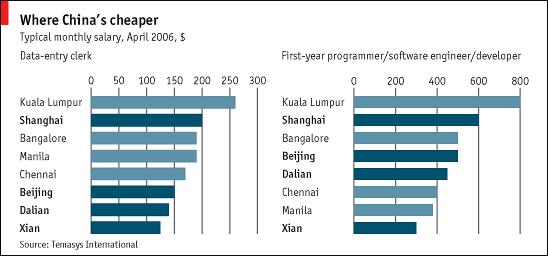The offshore opportunities for China can be tremendous given time and effort. China only has 10% of the global market in offshoring. The offshoring to China is mainly in manufacturing, but some outsourcing services exist.
The cost of labor in China being relatively cheaper than in India is another advantage for China. The salary of a computer engineer in China is 70% lower than a salary of an engineer in the United States. As salaries of Indian engineers and programmers begin to rise, many companies might consider China as an alternative to India. Companies that have outsourced are IBM, Hewlett-Packard, Microsoft, Siemens, Infineon, NEC and Fujitsu. Many Indian companies are expanding to China. Companies such as Tata Consultancy Services (TCS), Infosys, and Wipro have offices in China.

Source: Economist.com
Employee turnover is comparatively low to India and other outsourcing destinations. At Indian firms, turnover is very high, which creates pressure on wages to keep employees from leaving. China, meanwhile, has an ample supply of employees that want entry-level experience. Chinese culture has more loyalty to employers than Indian culture, according to Information Age. This makes attrition rates very low. However, if more companies start outsourcing to China, that trend may change.
Additionally, China has policies about foreign ownership of companies. The economy is ripe for foreign investment, but China often requires company to partner with a Chinese-owned company to do business in the company. For many foreign companies, setting up an outsourcing deal means gaining access to the growing and lucrative Chinese market.

Google China Office after Google decided to withdraw from China. Source: Flickr
However, there are significant drawbacks of the offshore opportunities in China. First is the limited number of skilled workers who have strong English skills. To combat this, the Chinese government is spending heavily to increase English education in the country. English is a required language to learn in school now, but many older workers did not learn it.
As discussed in the educational section, the supply of workers is great, but the quality of the work is still questionable. Graduates may have degrees, but their skillset may be more limited than workers with the same degrees earned in other parts of the world. Additionally, engineers who have the skills and experience to handle international projects are very limited. IT companies are not willing to budge on the quality of their workforce and expect their employees to skilled enough to work on their projects, which may immediately eliminate China.
China is aging, unlike India. In India, 60% of the population is under 30 years old. In China, a one child per household policy exists, meaning that most of China's population is around 40, and the average age keeps rising. This may mean fewer workers will be available in China in the future.
Finally, companies need to consider the value of their intellectual property. In 2010, hackers that were traced back to China broke into at least 34 companies in the United States. Wired reported in January 2010 that attackers were targeting source-code repositories of the companies, and in many cases were successful in gaining access.
Google was one such company, and said that hackers had stolen intellectual property and sought access to Gmail accounts of human rights activists. The incident led Google to end its censored search engine in China. Users were instead redirected to its uncensored search engine in Hong Kong, but the Chinese government censors the results there by preventing network connections for sensitive searches. At the time, it was unclear whether Google would have been allowed to continue to operate within the country if it took those actions. Google was allowed, but this incident showed that dealing with the Chinese government on security issues could be a tricky subject.
Because of these serious intellectual property issues, companies may want to consider which parts of their code that outsourcers work on in China. Additionally, companies should also consider whether subsidiaries in China have full access to the company network.